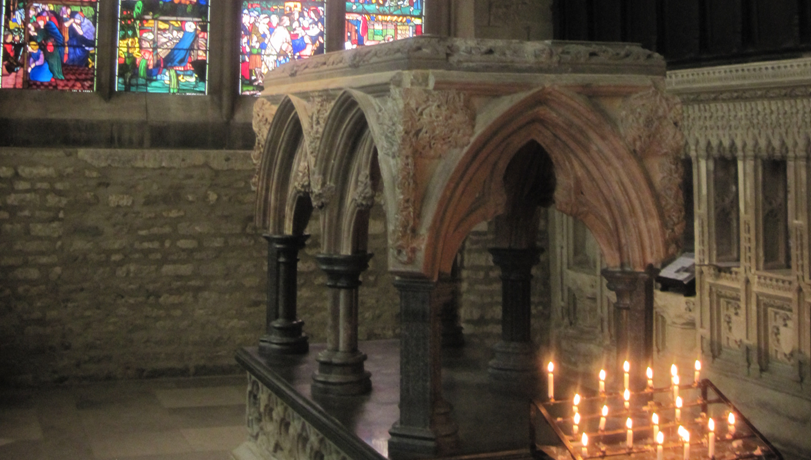St. Bede writing in a scriptorium, and the shrine of St. Bede.
Bede entered into the monastery of Monkwearmouth, Northumbria as a young boy. He was educated from early on in the Benedictine, monastic tradition by the Abbot Benedict Biscop, so called for his patronage of the rule and lifestyle of St. Benedict, and later by Abbot Ceolfrith. He narrowly escaped death with Ceolfrith, as the only literate survivors of a plague that killed monks at his monastery in the late 7th century. Bede was ordained in A.D. 703 at age 30, as was the tradition (therefore he was born in 673). Bede is best known for his many written works, many of which are the soul sources for their time that have survived until now. His
Lives of the Abbots follows the works of the abbots of Monkwearmouth, namely Benedict and Ceolfrith. He also wrote the
Vita Sancti Cuthberti, which is a biography of St. Cuthbert and reveals much about the growing Northumbrian cult. The best known work is the
Historia Ecclesiatica Gentis Anglorum, or the
Ecclesiastical History of the English Peoples, which covers the geography of the island, and traces Christianity in Britain through St. Columba, St. Ninian and the Scottish and Welsh Churches, and the history of the Church among the Anglo-Saxons going all the way back to St. Augustine and Pope Gregory. Bede best covers the Anglo-Saxon Church, recounting the lives of many saints including St. Etheldreda, St. Chad, St. Hilda, St. Wilfrid, St. Theodore, St. Cuthbert, St. Aidan, St. Oswald and many others, as well as ecclesiastical events such as the synods of Hertford, and Whitby. He was so devoted to his writing and to his other monastic duties that he died singing the 'Gloria Patri.' His relics were enshrined at Jarrow, where he died, but later taken to Durham, where they lie still in the Galilee chapel. Bede is venerated as one of the great lights of the ancient Church of England, St. Boniface himself said "The candle of the Church, lit by the Holy Spirit, was extinguished."
Heavenly Father, who dist call thy servant Bede, while still a child, to devote his life to thy service in the disciplines of religion and scholarship; Grant that as he labored in the Spirit to bring riches of thy truth to his generations, so we, in our various vocations, may strive to make thee known in all the world; through Jesus Christ our Lord, who liveth and reigneth with thee and the Holy Spirit, one God, for ever and ever. Amen.
Sources...Oxford Dictionary of Saints, and 1979 BCP









